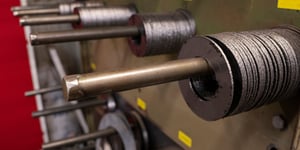You’re gradually sifting through a mountain of gasketing material resources when you notice somebody referring to graphite gaskets.
But what makes graphite gaskets different from all the other sealing materials you’ve seen?
The gasketing projects at Strouse use many different materials to fit each design’s purpose. If flexible graphite seems like your ideal material, then it’s essential to understand its characteristics before going into production.
As you read, you’ll learn more about graphite gasket uses, pros and cons, and where to find them if they fit your project.
What Are Graphite Gaskets Used For?
Graphite is a non-porous material with a high melting point. Graphite gaskets are primarily used for high-temperature, high-pressure sealing solutions.
Some common examples of graphite gasket uses are exhaust pipes, head gaskets, oil and petrochemical facilities, vehicle engines, corrugated metal gasket coatings, and dynamic or shaft seals.
In addition, they are often looked at as non-metallic and non-asbestos gasketing alternatives.
GRAPHITE GASKET MATERIAL
Flexible graphite is a soft material that can get into surface irregularities once compressed, leading to a sealing effect. It can also be used as dynamic seals for equipment in motion because it has some natural lubricant that minimizes shaft wear.
Some graphite properties depend on the level of purity of the material you use. For instance, high-purity graphite can be brittle, which isn’t suitable for every project. You’ll want to choose a material that suits your purpose or factor additional support into your final design.
Additional support often comes in laminated foils or attached wire mesh, reinforcing the gaskets.
MAXIMUM TEMPERATURE FOR A GRAPHITE GASKET
Graphite can typically withstand temperatures up to 850 degrees Fahrenheit, although this could depend on the material blend.
Compared to other heat resistant gasket materials, graphite gaskets have a lower thermal expansion, meaning they’ll keep their size under the high temperatures they might encounter. Thermal expansion can cause pipes carrying hot water or steam to burst.
You might therefore choose a graphite gasket, which has a low chance of changing shape, for high-temp applications where you don’t want thermal expansion.
Finally, it’s worth noting that lower-grade graphite might contain impurities that oxidize in temperatures lower than expected, causing seal failure. Matching the grade of your graphite to your temperature requirement will help prevent these types of accidents.
How Do Graphite Gaskets Compare to Others?
Flexible graphite gaskets can reach high temperatures while maintaining resistance to liquids and gasses. Yet, any higher than 850 degrees Fahrenheit, you’ll want to consider using mica or vermiculite.
Graphite gaskets are fire-safe but non-reusable. They also have a higher tendency toward oxidation and lower tensile strength.
While graphite is softer and can suffer from cracks, flexible graphite seals remain sturdy when compressed between flanges. Depending on your design and chosen material, they can be more affordable than other options.
Where Can I Find Graphite Gaskets?
Finding graphite gaskets will depend on the complexity of your gasket material and design.
If you need a simple, circular graphite gasket, you can likely find premade gaskets of the proper specifications from one of many industrial supply stores. However, gaskets with more complex designs or made from high-purity graphite sheets might be more challenging to acquire.
When searching for custom gaskets, you’ll find yourself stumbling upon flexible material converters like Strouse, who offer to make your design.
If you want custom gaskets in large quantities but you’re worried about how much custom gaskets cost, contact us for a quote:
%20(1)-min.png?width=290&name=Untitled%20(52)%20(1)-min.png)






